How EDEKA is optimizing the receipt of goods with the help of SICK

As a major player in the German retail sector, EDEKA is pursuing an ambitious goal. By 2025, the Group aims to invest 450 million euros in the automation, innovation, and expansion of its warehouses. These plans are already taking shape at one of their sites.
EDEKA knows the importance of optimized processes to ensure smoother workflows, increase productivity, and have a positive impact on a company’s success. The food and beverage retailer recognized significant areas for improvement in receiving goods. For example, the company currently has goods delivered by truck on pallets from various manufacturers – including pallets that are subject to a pallet deposit and pooling system.
The manual classification of deposit pallets when receiving goods requires a high use of resources, causing a higher potential for error that should not be ignored. EDEKA entered an innovative partnership with SICK to avoid these costly mistakes, save resources, and simultaneously increase process quality and transparency.

Making Pallet Classification Easy
The Pallet Classification System (PACS) for automatic pallet classification was developed in close cooperation between SICK Sensor Intelligence and EDEKA. The company was looking for a way to improve the classification process for delivered pallets and received goods.
In addition to deposit and pooling pallets, such as EPAL or CHEP, there are also pallets that are not subject to the deposit system due to incorrect and manual sorting processes. Previously, to avoid incorrect deposit payments to suppliers, each incoming pallet has been manually classified according to its deposit relevance. This is made possible by staff needing to recognize the color and the label/branding on the pallet block. Ultimately resulting in an error-prone, time-consuming, and resource-intensive process.

Improving the Current Process
This current process shows us the importance and benefits that optimization would have for EDEKA’s new (and current) facilities.
“It is important for us to know whether the pallet has a deposit or not. Now, the process is completed manually by an employee when receiving goods. Our joint project with SICK will change this in future, as the pallet type will be recorded automatically,” said an EDEKA representative.
In addition to the design and development of the Pallet Classification System, this joint project with SICK also involves some changes to their current plant. Some of these new efficiencies include adding two color cameras for image acquisition, a light barrier arrangement for triggering the pallet, and a controller for processing data and executing the pre-trained AI-based neural network.
Additionally, adding an optional third color camera that can be mounted above the conveyor system, to document and track the load on the pallet.

Here’s How It Works
During the automated pallet transport process, two color cameras capture the labels/branding on the outer blocks of the pallets and record RGB images of each brand identity. With the help of a pre-trained artificial neural network, the system uses branding images to determine the pallet type (e.g., EPAL, CHEP or UIC).
As brandings often differ greatly in quality or usage, a training process for the network is needed to increase the accuracy of the different pallet types. In addition, the system can also be retrained with additional pallet types for a higher recognition success rate. Creating a simple and flexible palletization solution to EDEKA’s unique requirements.
Customized Pallet Solutions Made Easy
This collaborative solution enables precise classification for smooth pallet management. With its ability to be simply integrated into the existing warehouse and its small size, this system can be installed in many positions along the conveyor system. Combined with standard sensor technology from SICK, it is easy to maintain and service as well!
Unlike conventional image processing solutions, no specific know-how is required to operate it. The use of deep learning technology in this SICK solution does not require detailed programming knowledge, because the system learns from specific examples. Making sure the currently supported pallet types can be easily expanded. Ultimately, this enables SICK to make custom pallet classifications for EDEKA simple.

Pallet Classification System
This pallet classification system can be optimized for multiple work processes due to because of many different factors. Firstly, by having the automatic pallet classification take place during operation removes the need for manual processes. This way staff can concentrate on processes with higher added value.
Additionally, pallet types such as EPAL, CHEP and UIC no longer must be checked manually – classification takes place quickly, automatically, and reliably. Secondly, at the same time, the transparency of the pallet stock is increased.
This is because the recorded data is transmitted to a higher-level warehouse management system (via a defined interface) on SICK’s own controller, which is precisely tailored to EDEKA’s requirements. Meaning that it is always clear how many deposit-relevant and non-deposit-relevant pallets have been received, ultimately making incorrect deposit payments a thing of the past.
The Success Speaks for Itself
The partnership with SICK has enabled EDEKA to fully optimize automation its potential and processes of receiving goods in its new and old warehouses for the future. Despite the complex requirements by working collaboratively with SICK, it was possible to develop a standard for pallet classification that is being continuously expanded as we speak.
Furthermore, EDEKA warehouses are to be equipped with PACS, which will increase the constructive cooperation between the two companies for a more efficient palletizing process in the future.





